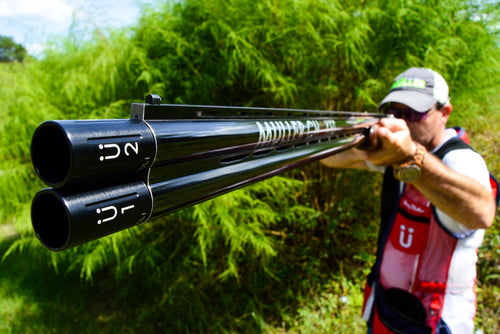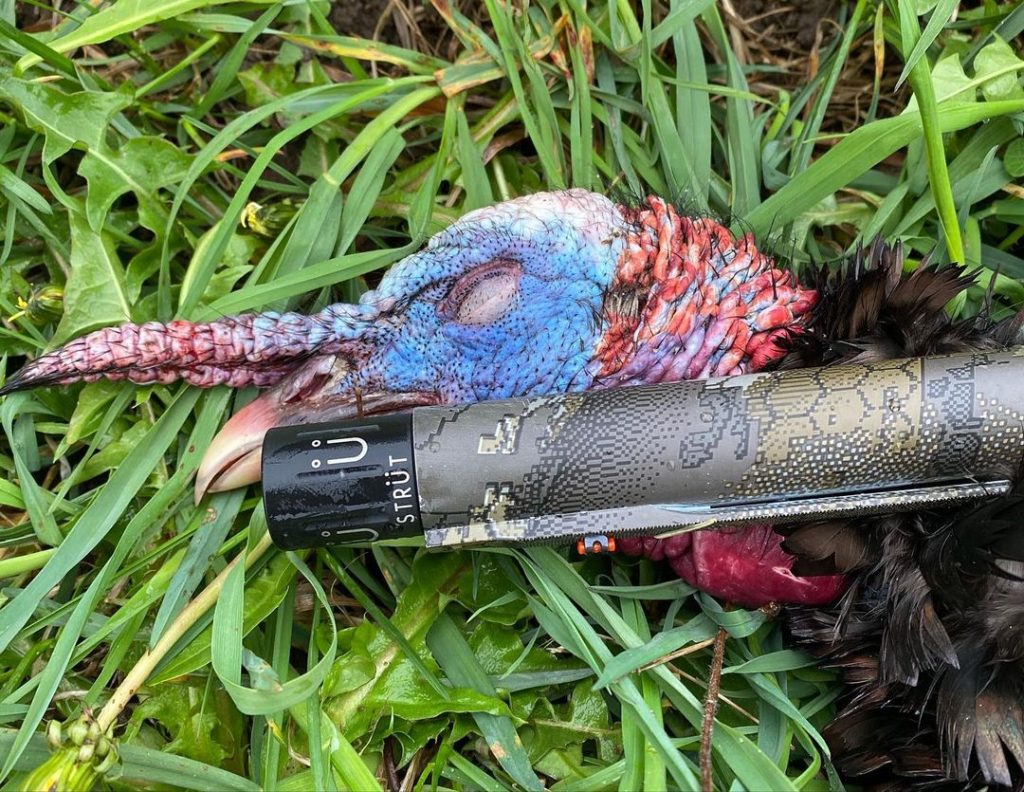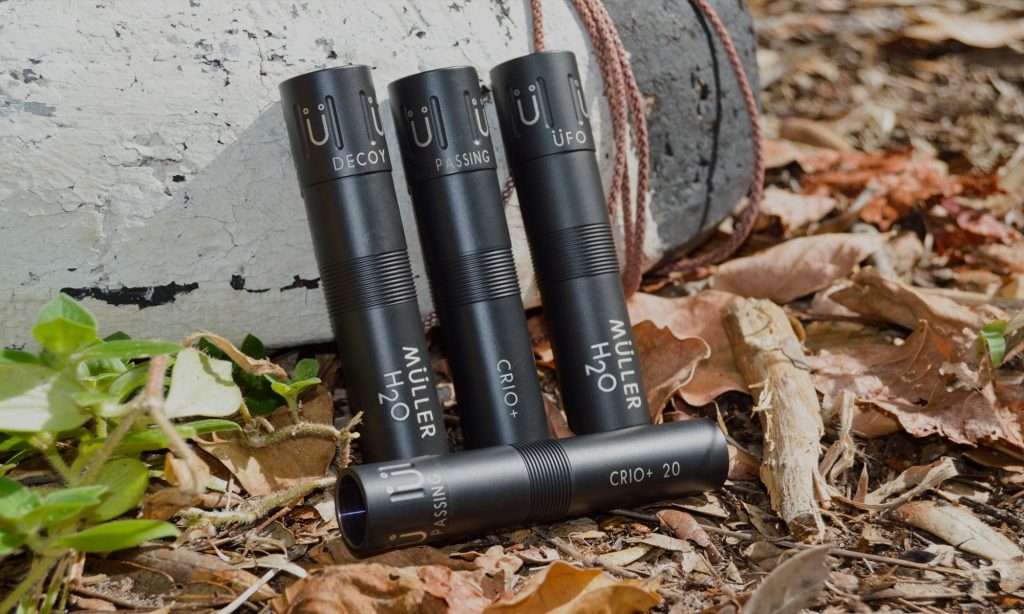What’s the Best Choke for Turkey Hunting?
I had been listening to this gobbler drumming for close to 90 minutes. He was just out of sight, no more than 60 yards away. My butt, back, and wrists were killing me from holding myself perfectly still waiting for him to break strut. Just when I thought I couldn’t take it anymore, I saw that devilish red head and black body emerge from the pine plantation and onto the logging road I was set up on. He was heading right towards me. As he neared my location, I excitedly prepared to squeeze the trigger. Now what I’d like to tell you is that when I took the shot, my extensive scouting, excellent woodsmanship, and abundant patience resulted in a shot that caused that bird to drop stone dead right there in his scaly-toed tracks. What actually happened is I watched one single feather drift slowly to earth while my prize flew over the nearby treeline. My first miss on a turkey really hurt, and it also stoked my fire to learn more about optimizing my shotgun with a choke for turkey hunting that would give me dense enough patterns to routinely take longbeards at ethical ranges. What I wasn’t ready for was just how tall of an order this was going to be.
Turkey Choke Tubes Explained
The choke works by constricting the diameter of the shotgun barrel, which causes the shot to form a tighter pattern (in theory) as it travels toward the target. The degree of constriction is measured in terms of “choke” or “constriction,” which refers to the difference in diameter between the bore of the shotgun and the diameter at the end of the choke. The effect of a turkey choke on the pattern of a shotgun can be significant. A tighter choke will produce a narrower pattern of shot, while a looser choke will produce a wider pattern in most cases. For turkey hunting, a tight choke is typically preferred because it allows the hunter to shoot at longer ranges. This is important because turkeys have small vital areas, and hitting those areas at longer ranges requires a tight pattern of shot.
Variables You Must Analyze To Find The Best Turkey Choke
After that miss, well, I don’t like to call it a miss, let’s call it a professional oversight…I was determined to hit the patterning board and find the best turkey choke for my 12 gauge and 20 gauge. So I rounded up several different chokes for shotguns that I liked to hunt with along with several different manufacturers’ ammo and invited some buddies to bring their guns and choices for a day at the range. Surely, by the end of this, we’d all have a combo that was hateful on turkeys. What we found out was that we had a lot more to learn about how turkey chokes change with different variables.
Shotshells
The type of ammunition used can have a significant impact on the performance of a choke. I figured that if we found a choke that worked well in my gun, that same choke would also work well in my buddy’s shotguns. Turns out, the best turkey choke for a Mossberg 500 is not necessarily the best turkey choke for a Remington 870. Why is this? One answer might be the shotshell. Heavier shot and smaller shot sizes will generally produce a denser pattern, while lighter shot and larger shot sizes will produce a looser pattern. 3-inch shells hold more shot than 2 3/4-inch shells and 12 gauge shells hold more than 20 gauges, etc. TSS Patterns are different than lead, and various wad designs can produce different patterns.
Shotguns
As you might now expect, the best turkey choke for a 12 gauge is not necessarily the best turkey choke for a 20 gauge. Or maybe it will be. Different shotguns can have different barrel lengths, chamber sizes, and internal dimensions, which can all affect the performance of a choke. The same choke may produce different patterns when used with different shotguns, even if those guns share similar actions and barrel lengths.

Shotgun sports enthusiasts often shoot double barrel shotguns to take advantage of having multiple chokes available for different types of shots they face.
Chokes
After beating ourselves up really well that day (turkey loads kick hard!) we learned that not all turkey chokes of a certain constriction are going to perform the same. While a tighter constriction generally produces a narrower pattern at longer distances, there are other factors that can affect the performance of a choke, such as the design of the choke, the type of shotgun, and the ammunition used. So with all of these variables to consider, how is a turkey hunter going to determine which configuration will produce the best pattern? The answer is testing. If you want to be sure that you have the best possible pattern, you have to test every choke tube on the market with every shotshell on the market at both close-range and long-range distances common to turkey hunting.
What Choke to Use for Turkey
Jimmy Muller is an aerospace/defense manufacturer. His years of experience as a master tool maker, metallurgist, and mechanical engineer, and a degree in the heat treatment of metals along with a passion for all things wing-shooting and shotgunning led him to combine these areas of expertise and form Muller Choke Tubes. I recently caught up with him on an episode of the Huntin’ Land Podcast to ask him just what a hunter should do to insure they’ve got the best patterning choke for their turkey gun.
Q: When I think about turkey chokes I’m thinking like really tight, heavily constricted chokes, but how does that choke affect the pattern?
A: “A lot of people think the tighter the exit diameter, the tighter it’s going to shoot, and that’s simply not the truth. It’s not the case due to physics. It also is not the case based on shot size, shot material, velocity, payload, bore diameter, and a shotgun barrel that you’re actually using. These are all things that affect patterns tremendously. And it’s something that pretty much nobody’s really ever touched on or talked about, or taught us. All we’ve been taught is, go with a tighter choke and shoot a tighter pattern. But that’s not what happens.”

The proper turkey choke will give you the right spread pattern for taking down turkey at distance.
Q: Some people want to call it a certain thing, they’ll say it’s a 665, or 565, or whatever it may be. Are all chokes of a certain constriction gonna perform the same?
A: No, they’re not. So back in the day when the choke was defined, patterns were defined at 40 yards in a 30-inch circle. A full choke is 70% of your pellets in a 30 inch circle at 40 yards, a modified is 60%, an Improved cylinder is 50%, and so on. So full choke was always defined and still is defined as 30 thousandths of an inch constriction and what that 30 thousandths of an inch is from your bore diameter. So that’s where the problem comes in. If you take Benelli SBE3 or Beretta 303 those barrels [bore diameter] vary from point .719 up to about .724. And they average about .721 and a half. So, if you take that as a round number 720, okay, and you put .030 constriction in it, that’s going to be 690. That’s full choke. However, what happens when you take a Browning invector plus gun that measures .745 and you put .030 constriction on it? That’s .715 and .715 exit diameter is not same as .690. So why can we say they’re both full choke? We can’t, but that’s what choke manufacturers and shotgun manufacturers and ammo manufacturers have always said. It’s not real, it’s not true.”
Q: So there’s no real standardization?
A: There is no such thing as a standard. It’s something that nobody’s ever talked about because it does get too vast. And to be honest with you, I really don’t think that any choke manufacturer or any gun manufacturer, or any ammo manufacturer has ever really done the in-depth testing that I’ve done to discover all these variables. And even if there is anybody that has done it, really do they care? Because they’re selling chokes, they’re selling guns, they’re selling ammo, they’re doing great. They just really care about selling stuff, making money, and getting it out there and in public. And hunters are the ones that are suffering as the end user.”
What is a Good Pattern For Turkey?
Q: One of the disturbing trends I am seeing in the world of turkey shotgun patterning is way too tight of patterns. I’m hearing guys bragging about killing turkeys beyond 50 yards but I’m also hearing about guys missing turkeys at 10 yards with $12 shells. What gives?
A: “So basically, what I’ve seen over the years is choke manufacturers have gotten away from reality in regards to hunting in the field. And what I mean by that is everything you see in marketing these days is 400 pellets in a ten-inch circle at 40 yards. Well, hurray for you if you’re shooting card tournaments. But the reality is, you only need four pellets to the head and neck to consistently and humanely dispatch turkey. Over the years, patterns have just become tighter, tighter, tighter, smaller, smaller, smaller, at insane distances, and now you add TSS into the game, and it’s even tighter.
As a turkey hunter since 1975, I’ve shot hundreds of turkeys, and what I’ve realized from talking to hunters and professional guides across the country, is that there’s only a handful of people that have ever shot a turkey past 50 yards. And of that huge percentage, 90% of them have shot their turkey inside 35 yards, and a huge percentage of that number, It’s been inside 25 yards. So what I wanted to do was make a choke tube for turkey that will actually benefit hunters. And so what I did was I came across a different methodology. And what I realized was let me make a choke tube that is going to be beneficial inside 20 yards, but also very lethal out to 50 yards with a lead shot. Because let’s face it, most people use lead shot because not everybody can afford $10 a shot for TSS. That’s why I designed my UFO turkey choke the way I did. I want it to be forgiving, but at the same time dependable.
What Choke Do You Use for Turkey Hunting?
I wish I had a nickel for every time someone asked me this question. And a nickel for every time I asked other hunters the same. It’s understandable, one would think what works well for others will work well for them. Unless you and your friend have the exact same gun, it’s useless to discuss what choke will work best. It’s important for turkey hunters to test different chokes with their shotguns and ammunition to determine which combination produces the best performance for their needs. So now that we know that every variable affects your pattern. What’s a hunter to do to figure out which configuration is best without spending thousands of dollars and tons of time at the patterning board? I asked Jimmy the same question:

Muller chokes have been extensively tested to provide the best spread pattern for many different shotguns.
Q: How are you able to take the same choke and put it in a Benelli or Remington or Winchester or Browning and get consistent patterns?
A: “So basically everything that’s been out there, you can’t. So what I did with my chokes is I created gun-specific pattern geometry. So I took every gun on the market with every bore diameter with every barrel length with every ammo on the market. I started with one gun and I changed every geometry you could imagine in the choke tube to using very premium ammo until I got a picture-perfect pattern out of that gun with the lowest shot-to-shot deviation, meaning 3-5% every shot, with the most even pellet counts from the inside 20-inch core all way up to 30-inch fringe. And when I achieved that for that gun, I drew the blueprint for that choke, and I moved on to the next gun and started that entire process over. So every one of my chokes for every single gun has its own taper length, parallel lane, gas girth clearance, surface finish, tangent radius blend where two to join, you name it, even overall length. So based on what I found to be the best that that gun was capable of producing.”
Closing Thoughts on Which Shotgun Choke is Best For Turkey Hunting
Whether it’s a health scare making you assess your nutrition, exercise, and stress or a missed turkey making you question the shotgun choke you choose, It often takes a negative experience to get you interested in a topic. You can spend hours and hours of your own time and thousands of dollars searching for the truth but it doesn’t always have to be that way. Find an expert who can share their experience so that you don’t have to learn the hard way as they did. If you’re looking for the best turkey choke, make sure you ask for advice from hunters who have patterned your exact gun and have optimized a pattern that will perform at all ranges, not just long ranges, because at the end of the day, turkey hunting is really about getting them close and making a clean, one shot kill.
Full Disclosure: This post may include affiliate links. There’s no extra charge to our readers for using these.
